Will a transmission fluid flush fix shifting problems?
What causes transmission shifting problems?
Many drivers ignore transmission maintenance and think that a transmission fluid flush will fix shifting problems. In a small number of cases, a transmission fluid flush can help with shifting issues, but it depends on how damaged the transmission is in the first place.
How a transmission clutch pack works
Automatic transmissions are made with several clutch packs.
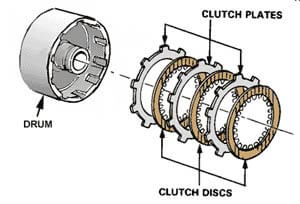
A transmission clutch pack includes a clutch drum, clutch friction discs, clutch plates (often called “steels:) and a piston and lip seal
Think of a clutch pack like a coffee can with a shaft running through the middle. The pack is loaded with alternating steel discs and clutch discs. The clutch discs have teeth on their inner diameter and engage with the shaft, while the teeth on the steel plates engage with the clutch drum. The entire disc pack fits into the clutch drum and a piston and lip seal are added, along with a locking ring.
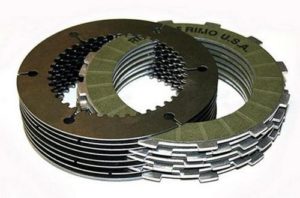
Alternating clutch discs and steel discs
When the clutch pack isn’t needed, a large band tightens around the clutch drum to prevent it from turning. There’s no fluid pressure inside the drum, so when the shaft spins, it turns the clutch discs freely. However, when the transmission requires that gear, it applies fluid pressure to the drum, causing the clutch discs against the steel discs. So the turning
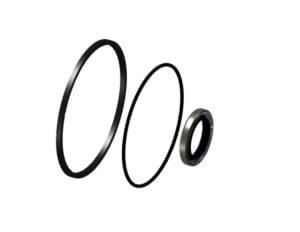
Clutch pack piston lip and shaft seals
shaft then rotates the clutch discs where are held against the steel disc due to the high pressure. Since the steel discs are splined to the drum, the entire drum turns and the gear mounted on the end of the drum provides a different gear ration.
What goes wrong with a transmission clutch pack?
The piston lip seal is the most critical component of a clutch pack. Automatic transmission fluid can get very hot and over time that hot fluid can cause rubber seals to harden and crack. If the clutch pack lip seal develops cracks, the discs inside will slip when they should be held solidly against one another. That slipping action causes the clutch discs to heat up and deteriorate. That extra heat further degrades the transmission fluid and the particles generated by the wear can clog cracks in the clutch piston lip seal. The particles can help the lip seal create a better seal, but it’s not a lasting fix because the particles flush out, leaving the cracks open to pressure loss again.
Internal seal leakage is what causes shifting problems
The bottom line is that leaking seal cause clutches and bands to wear, slip and generate excessive heat. That deteriorates the transmission fluid. So burnt transmission fluid is the EFFECT of leaking seals and shifting problems, not the cause. In other words, by the time you’ve got shifting issues, the damage has already been done.
Can a transmission fluid flush fix shifting issues?
In most cases, no. It’s too late. Thinking that a transmission fluid flush will fix shifting issues is like expecting an engine oil change to fix a neglected worn out engine. However, there are a few instances where a transmission fluid flush along with fluid additives like Lucas transmission can fix shifting issues.
When can a transmission fluid flush fix shifting issues?
Old worn out fluid loses prevents clutch discs and steel discs from bonding when under high pressure because the fluid’s friction additives are depleted. Fresh transmission fluid contains new friction enhancing additives, along with seal conditioning additives. If you catch a shifting issue very early, a transmission fluid flush can sometimes fix shifting issues. The fresh fluid helps clutch discs and steel discs bond and hold without slipping. The seal conditioners in the new fluid help soften the clutch piston lip seals so they seal better.
But, a transmission fluid flush can’t fix these shifting issues
• A transmission fluid flush can’t fix cracks in clutch pack seals.
• A transmission fluid flush can’t fix worn clutch discs.
• A transmission fluid flush can’t fix worn bands
• A transmission fluid flush can’t fix worn servo seals
• A transmission fluid flush can’t fix worn valve body passages
• A transmission fluid flush can’t fix worn valve body valves
• A transmission fluid flush can’t fix excessive clearances
• A transmission fluid flush can’t fix transmission pump issues
• A transmission fluid flush can’t fix torque converter wear
• A transmission fluid flush can’t fix worn bushings
• A transmission fluid flush can’t fix worn bearings
• A transmission fluid flush can’t fix worn gears
Which transmission fluid additives help shifting issues?
Lots of companies make transmission fix additives. Most of these
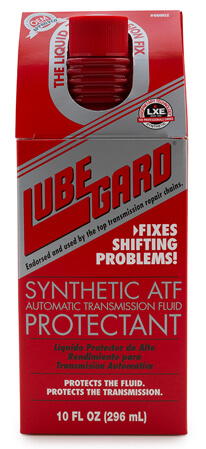
Lubeguard Automatic Transmission Protectant
“Miracle in a bottle” products don’t work. They’re simply seal swellers that soften rubber seals so the seal better. But the fix doesn’t last. There is only one product I recommend and it’s the same product that’s been endorsed by most car makers: Lubeguard. Most transmission rebuilders add this additive after a transmission rebuild. I’ve used it and I highly recommend it.
When added after a transmission fluid flush, LUBEGARD ATF Protectant reconditions seals, reduces “shudder” caused by frictionally depleted fluid. Shudder is often referred to as “stick slip.” The ingredients in Lubeguard ATF protectant help solve shudder problems. In addition, Lubeguard ATF protectant raises the transmission fluid’s thermal and oxidative stability and increases the fluid’s ability to transfer heat.
The other Lubeguard product that helps is Lubeguard Instant Shudder Fixx
Lubeguard Instant Shudder Fixx contains a specially formulated
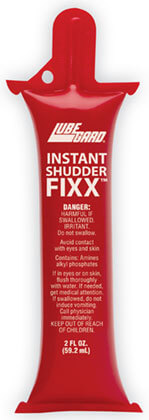
Lubeguard Instant Shudder Fixx stops the shudder when the transmission shifts into overdrive
friction modifier designed to instantly eliminate torque converter lock-up shudder. Lock up shudder occurs during the “lock-up” phase when the torque converter provides 1:1 power to the transmission. In the process of locking up, the torque converter turbine locks to the clutch and rear housing. If slipping occurs during the pressure lockup, you get a momentary shudder. Lubeguard Instant Shudder Fixx eliminates the shudder when shifting into overdrive.
©, 2017 Rick Muscoplat
Posted on by Rick Muscoplat
